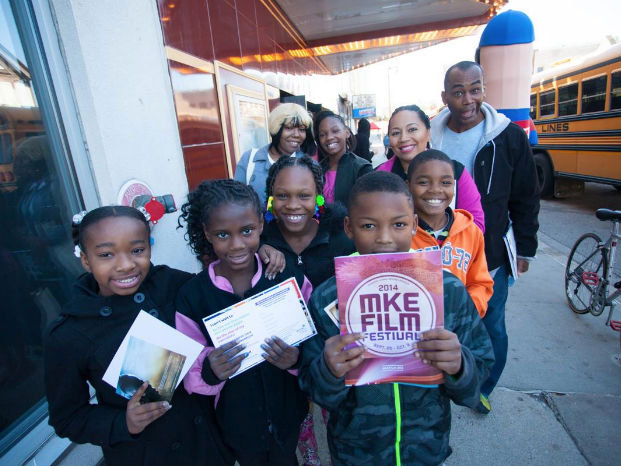On the morning of Wednesday, Oct. 7, large yellow buses parked outside of the Oriental Theatre on 2230 N. Farwell Ave. Inside the main lobby, staff members and volunteers stood by anxiously awaiting the arrival of nearly a thousand students, visiting the theatre from 15 different Milwaukee schools.
Eventually, school by school, students – ranging from grades 4 through 6 – teachers and chaperones filed into the theater and took their seats in the main house, waiting to be taken away by the beautifully crafted Spanish-language animated film "AninA." The screening was held as part of Milwaukee Film’s education screenings during the film festival.
Like every education screening, this was a private event and not open to the general public. During the festival, grade school students, ranging from elementary through high school, are given the opportunity to watch films that they otherwise wouldn’t see either at home or even in the classroom.
This is especially true for "AninA," an animated film in which looks like it was ripped out of a children’s book. It’s artistically crafted in such a detailed way that the story isn’t the only engaging aspect.
The story centers on a 10-year-old girl named Anina whose full name is what’s termed a "capicua," which means palindrome in Spanish. This means that her full name, Anina Yatay Salas, can be read both forwards and backwards. This is a quality that she absolutely hates, especially since her classmates have nicknamed her "the capicua girl."
She soon has bigger problems than her name, however, when she gets into a confrontation with Yisel, Anina's enemy who she calls "elephant" because of her overweightness. Following the confrontation, they both face consequences as they’re given a black wax-sealed envelope by the school’s principle.
The mystery of what’s inside of the envelope is just that: a mystery. The girls are forbidden to open it or tell anyone about it for the next week. This proves to be quite the task for Anina, who grows more curious about the envelope, not having a clue as to what lesson she’ll learn from it.
Cara Ogburn, Milwaukee Film’s education director, says that "AninA" is a film that had been on the children’s film festival circuit over the course of the last year.
In the early spring, she had received a screener copy of the film, watched it and became excited about it immediately. It was the first film she booked for the festival’s Rated K program and then decided that it was a great pick for an education screening.
"The film is one of the most carefully animated films I've seen for kids or anyone in a while," Ogburn said. "Upon watching it a second or third time, you notice all kinds of details in the animation."
Wednesday’s screening wasn’t just a trip to the movies to just be entertained. The films in the program, such as "AninA," are ones that’ll ideally teach lessons to students through the power of rich, cinematic storytelling.
The students responded quite fondly. Immediately following the screening, Ogburn took the stage and asked the students if they liked what they just saw. The response was a deafening yes.
Over the half hour or so that followed, students anxiously waited to speak their minds about the film and tell everyone the aspects that they had enjoyed the most. By the amount of small arms and hands that were in the air, it seemed like most of the students had at least something to say.
The responses ranged from a girl recalling a scene in which Anina and her crush run through a field of flowers as "romantic and lovey dovey" to a boy who said, "I liked the part where the boy fell off the tree and busted his head."
The learning doesn’t stop when the end credits roll, however. The Q&A following the screening was meant to start them thinking about what they’ll be talking about in the classroom, as teachers are expected to incorporate the film into their curriculum through various activities, extended conversations and a writing contest.
Ogburn says that she and others on staff try to make it as easy as possible for teachers to take the film and fold it into their classrooms. They offer curriculum that attends to a variety of Common Core goals that they can use as is or they’re encouraged to adapt for their own students or curricular needs.
"We try to pick films that allow for a variety of curricular connections," Ogburn said. "So for ‘AninA,’ there's activities involving social and emotional learning, writing, discussion questions that encourage thoughtful speaking and listening, an activity thinking about their own family traditions and names and even activities that engage with math concepts."
Ogburn says that teachers are expected to show evidence of how they’ve used the film in their classroom curriculum, but they’re open as to how teachers want to engage it.
"It’s great to see these young minds at work in the materials they send us," Ogburn said.
Ogburn noted that she was also excited that "AninA" was a Spanish language film, since that makes it – and its crucial lesson – unique and accessible to bilingual students as well.
"The film is primarily about issues of bullying or schoolyard quarrels – something I thought would be pertinent to these kids and that teaches a solid lesson while also showing how complicated these issues can be," Ogburn said. "I like the films we show school groups to be challenging, asking them to think about complex situations rather than a film that delivers a message didactically."
As made obvious by the students' response to "AninA," the message has resonated. It’s a film, however, that can resonate with anyone, young or old.
"The film teaches that sometimes the kids you don’t much care for or don’t understand because they act differently have something going on at home that’s difficult," Ogburn said. "And that, when you let down your own guard and biases, you can find commonalities and develop a kind of friendship."
Colton Dunham's passion for movies began back as far as he can remember. Before he reached double digits in age, he stayed up on Saturday nights and watched numerous classic horror movies with his grandfather. Eventually, he branched out to other genres and the passion grew to what it is today.
Only this time, he's writing about his response to each movie he sees, whether it's a review for a website, or a short, 140-character review on Twitter. When he's not inside of a movie theater, at home binge watching a television show, or bragging that he's a published author, he's pursuing to keep movies a huge part of his life, whether it's as a journalist/critic or, ahem, a screenwriter.







